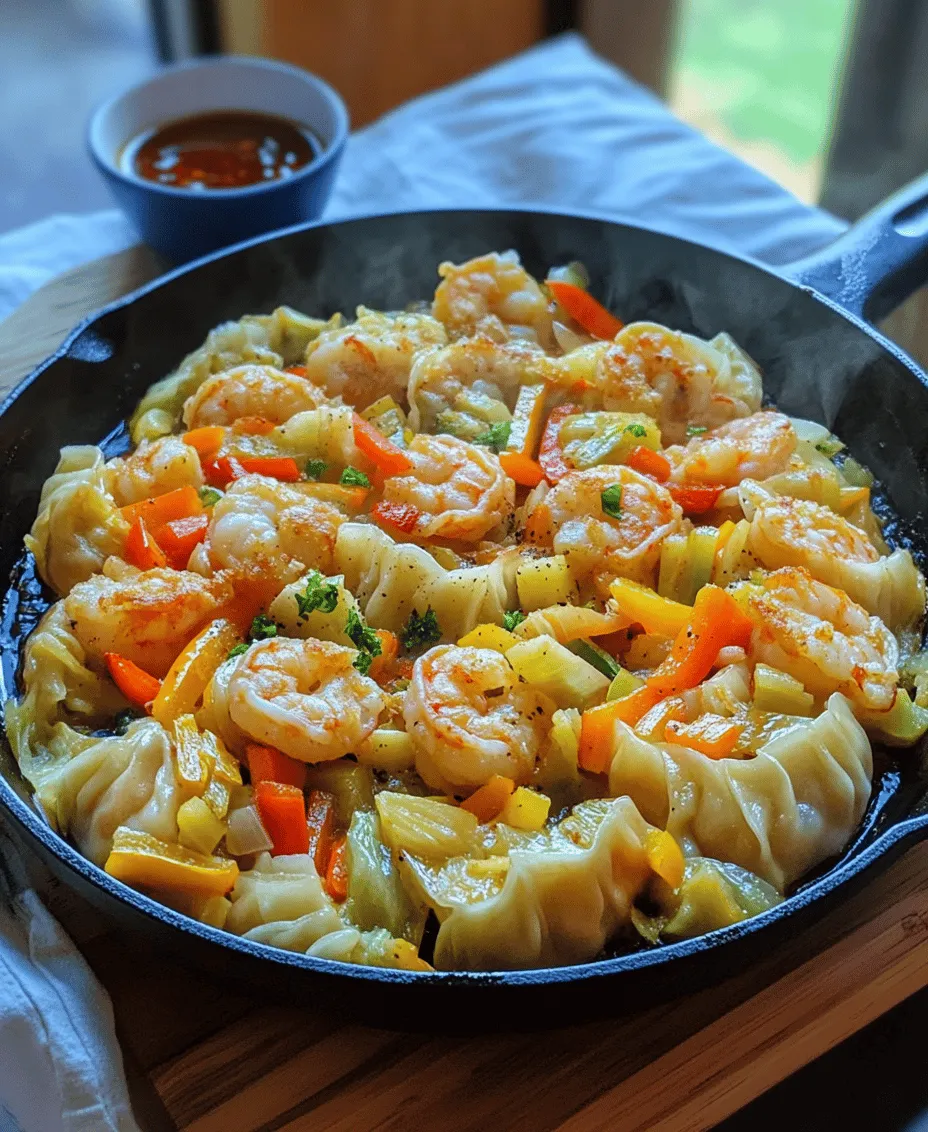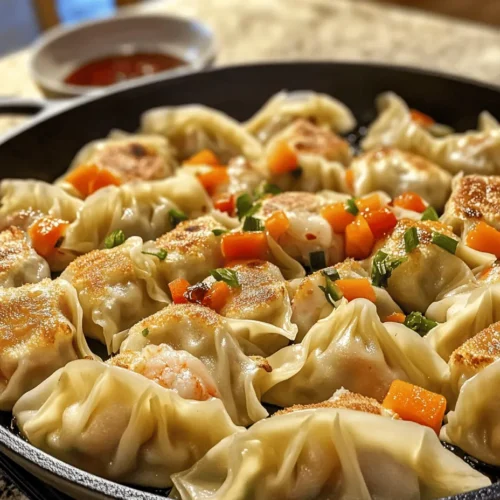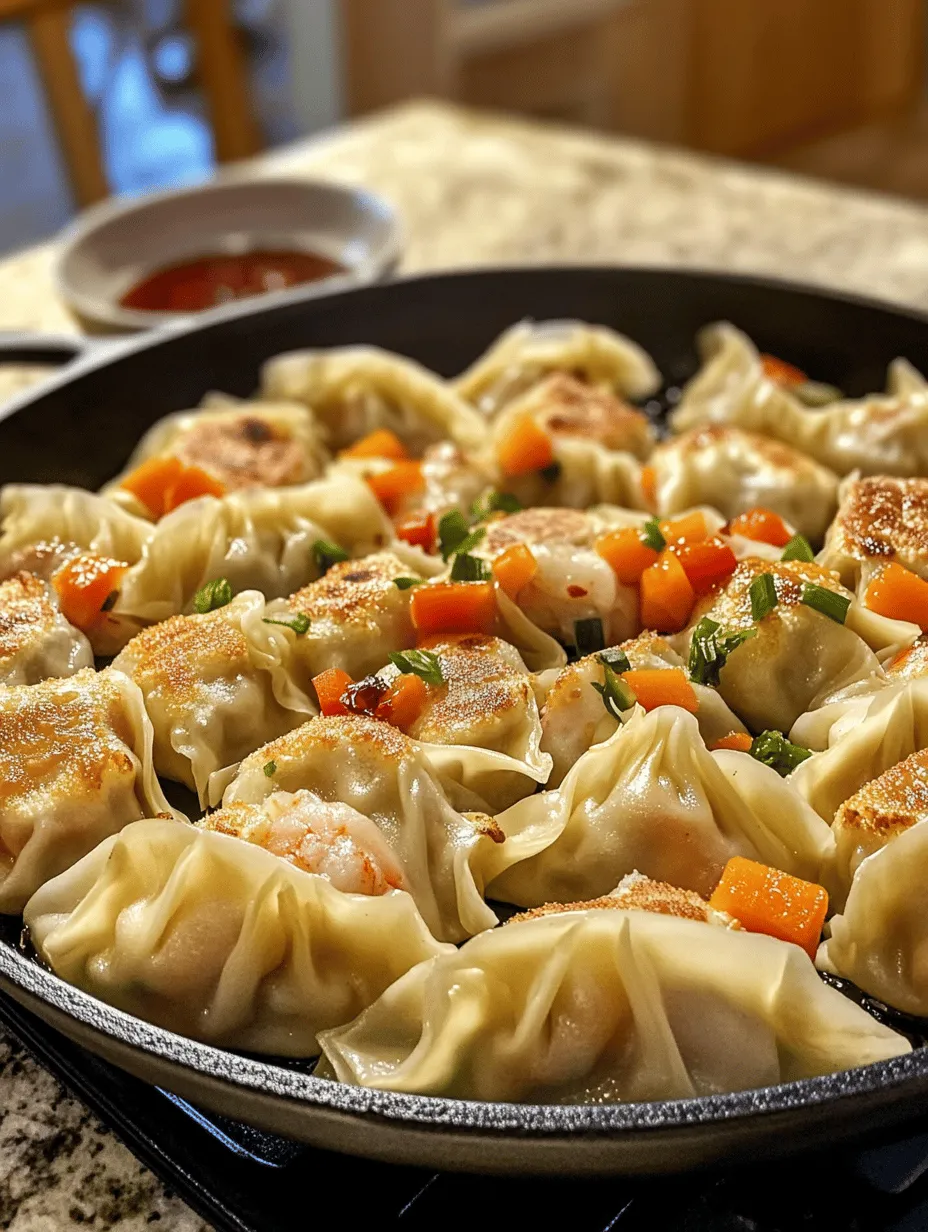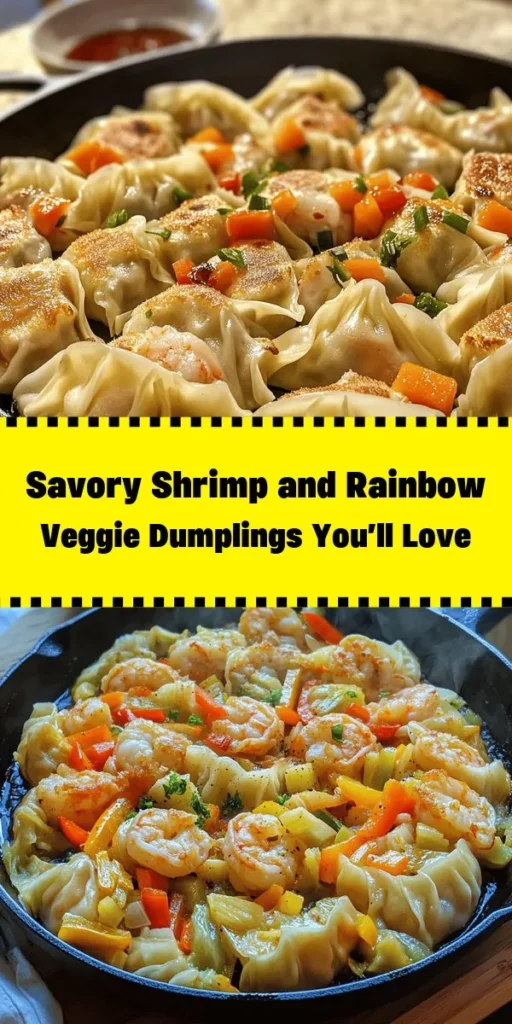Introduction
Dumplings, with their delightful bite and variety of fillings, have captured the hearts and taste buds of food lovers across the globe. Among these, savory shrimp and rainbow vegetable dumplings stand out for their vibrant colors and flavors, making them not only a feast for the palate but also a feast for the eyes. These dumplings are an irresistible combination of tender shrimp and a medley of fresh vegetables, all wrapped in a delicate dough. The appeal of this dish lies not only in its flavor but also in its health benefits, making it a nutritious choice that doesn’t compromise on taste.
Shrimp is a powerhouse of nutrition; it is low in calories yet high in protein, making it a popular ingredient for those seeking a healthy diet. Loaded with vitamins and minerals such as selenium, vitamin B12, and iodine, shrimp can contribute to heart health and support brain function. Coupled with a colorful array of vegetables—think bell peppers, carrots, and spinach—these dumplings provide essential nutrients and antioxidants that promote overall well-being.
Moreover, these dumplings exemplify versatility in the kitchen. They can be enjoyed steamed or pan-fried, served as an appetizer, or as a main course paired with a soy dipping sauce. Their cultural significance is profound, as dumplings are revered in many traditions worldwide, from Chinese jiaozi to Japanese gyoza and Polish pierogi. Each culture brings its own unique twist to dumpling-making, emphasizing the dish’s universal appeal and comforting nature.
The Art of Dumpling Making
Dumplings have a rich history that spans centuries and continents. They are believed to have originated in China over 1,800 years ago and have since become an integral part of various cuisines. In China, dumplings are traditionally served during the Lunar New Year to symbolize wealth and good fortune, while in Eastern Europe, they are often enjoyed during festive gatherings. This cross-cultural culinary tradition highlights not only the versatility of dumplings but also their ability to bring people together.
What makes dumplings especially beloved is their status as comfort food. The act of wrapping the dumplings by hand is not just a cooking technique; it’s a bonding experience shared among family and friends. Homemade dumplings can evoke nostalgia and warmth, reminding us of cherished moments spent in the kitchen. While store-bought dumplings can be convenient, they often lack the freshness and personal touch that comes from making them at home. The satisfaction of crafting your own dumplings is an experience that elevates the dish from mere food to a labor of love.
Ingredients Breakdown
A successful savory shrimp and rainbow vegetable dumpling starts with quality ingredients. Let’s break down the main components that will come together to create this delicious dish.
Shrimp
Shrimp is the star of this recipe, providing a succulent texture and a rich flavor that complements the crisp vegetables. Nutritionally, shrimp is an excellent source of protein while being low in fat and calories. A 3-ounce serving of shrimp contains approximately 20 grams of protein and only 84 calories, making it an ideal choice for a nutritious meal. Additionally, shrimp is rich in omega-3 fatty acids, which are known for their heart health benefits, and it contains antioxidants such as astaxanthin, which can help combat inflammation.
Mixed Vegetables
In this dumpling recipe, a rainbow of vegetables adds both color and nutrition. Each vegetable contributes its unique flavor profile and health benefits. For instance, bell peppers are rich in vitamin C, carrots provide beta-carotene, and spinach is packed with iron and vitamins A and K. Using a variety of colors not only makes the dish visually appealing but also ensures a wider range of nutrients. The combination of these vegetables creates a delightful crunch and freshness that balances the tender shrimp.
Garlic and Ginger
Garlic and ginger are essential aromatics in this recipe, enhancing the overall flavor and adding an aromatic punch to the filling. Garlic is well-known for its health benefits, including its potential to boost immunity and support cardiovascular health. Ginger, on the other hand, has anti-inflammatory properties and aids digestion. Together, they create a savory base that elevates the dumpling filling to new heights.
Soy Sauce and Sesame Oil
To deepen the flavor of the filling, soy sauce and sesame oil are used. Soy sauce adds a savory umami richness, while sesame oil brings a nutty aroma that is characteristic of many Asian dishes. Both ingredients work harmoniously to enhance the overall taste of the dumplings. Opting for low-sodium soy sauce can be a healthier choice without sacrificing flavor.
Fresh, Quality Ingredients
The importance of using fresh, high-quality ingredients cannot be overstated. Fresh shrimp and vibrant vegetables will not only improve the taste of your dumplings but also ensure that you are serving a nourishing meal. When shopping for shrimp, look for firm, translucent flesh with a mild scent—this indicates freshness. For vegetables, choose those that are crisp and brightly colored, as they will impart the best flavor and nutritional benefits.
Preparing the Filling
Now that we have a clear understanding of the ingredients, let’s dive into preparing the shrimp and vegetable filling. This step is crucial, as the filling is what makes or breaks the dumpling experience.
Step-by-Step Guide
1. Prep the Shrimp: Begin by peeling and deveining the shrimp. Rinse them under cold water and pat them dry with a paper towel. Chop the shrimp into small pieces, ensuring that they are uniform in size to promote even cooking.
2. Chop the Vegetables: Finely chop your choice of mixed vegetables, such as bell peppers, carrots, and spinach. Aim for small, uniform pieces so that they can easily be enveloped in the dumpling wrapper.
3. Combine Ingredients: In a mixing bowl, combine the chopped shrimp and vegetables. Add minced garlic and grated ginger for flavor. Drizzle in soy sauce and sesame oil, adjusting the quantities to taste. Mix everything thoroughly until the ingredients are well incorporated.
4. Texture Check: The key to a balanced filling is achieving the right texture. You want a filling that is moist but not overly wet, as excess moisture can lead to soggy dumplings. If the mixture feels too wet, consider adding a small amount of cornstarch or breadcrumbs to help bind it together.
5. Taste Test: Before assembling your dumplings, it’s important to taste your filling. Adjust the seasoning with more soy sauce, salt, or pepper as needed. This step allows you to ensure that the flavors are just right before they are sealed inside the dumpling wrappers.
Tips for Achieving the Right Texture
– Do Not Overmix: While combining the ingredients, avoid overmixing, as this can lead to a tough texture. Just mix until everything is combined.
– Chill the Filling: If time permits, chill the filling in the refrigerator for 15-30 minutes. This helps the flavors meld together and makes it easier to handle when assembling the dumplings.
– Consider Substitutions: For those looking for a vegetarian alternative, tofu can be used in place of shrimp. Crumbled firm tofu mixed with the same vegetables and seasonings can create a satisfying filling that retains the dish’s essence.
With our flavorful filling ready, we are now prepared to move on to the next exciting phase of crafting our savory shrimp and rainbow vegetable dumplings. This involves mastering the wrapping technique, which is essential for ensuring that each dumpling is sealed perfectly to hold in all the delicious flavors. Stay tuned for detailed instructions on how to wrap your dumplings like a pro!

Creative Folding Styles for a Decorative Touch
Creating the perfect dumpling is not only about the filling and cooking method; the way you fold your dumplings can elevate them to a new level of artistry. Here are a few creative folding styles you can try to make your shrimp and rainbow vegetable dumplings visually stunning:
1. Pleated Fold: This is the classic dumpling fold where you start by pinching the dough together at the center. From there, create small pleats on one side, folding over and pinching to seal. This style not only looks elegant but also allows for a nice filling-to-dough ratio.
2. Half-Moon Fold: For a simpler approach, fold the dumpling dough over the filling to form a half-moon shape. Press the edges firmly to seal. You can crimp the edges for a decorative touch, making them look more polished.
3. Braid Fold: This intricate style involves twisting the edges of the dumpling dough together to create a braided effect. It’s a bit more challenging but can be a fun way to impress your guests.
4. Flower Fold: Start with a small round piece of dough and place a small amount of filling in the center. Gather the edges and pinch them together at the top to form a flower-like shape. This design is perfect for special occasions and adds a lovely touch to your presentation.
Experiment with these folding techniques to not only enhance the appearance of your dumplings but also to make the cooking process more enjoyable.
Cooking Methods for Dumplings
When it comes to cooking your shrimp and rainbow vegetable dumplings, you have a couple of excellent methods to choose from: pan-frying and steaming. Each method offers distinct textures and flavors, making it essential to understand their benefits.
Pan-Frying vs. Steaming
Pan-Frying: This method involves cooking the dumplings in a skillet with a small amount of oil. The result is a beautiful golden-brown crust that adds a delightful crunch to each bite.
Benefits of Pan-Frying for Crispiness: Pan-frying creates a crispy exterior while keeping the filling moist and flavorful. The contrast between the crunchy outside and tender inside is a signature feature of well-cooked dumplings. To achieve this, ensure your pan is hot before adding the dumplings, and don’t overcrowd the pan to maintain the heat.
Steaming: Steaming is a gentler cooking method that retains the dumpling’s moisture and allows the flavors to meld perfectly. This method is ideal if you prefer a softer texture.
The Steaming Process and How It Retains Moisture: When you steam dumplings, place them in a bamboo steamer or a heatproof dish over boiling water. Cover the steamer with a lid to trap steam inside, cooking the dumplings evenly. Steaming is particularly beneficial for maintaining the vibrant colors of the rainbow vegetables, ensuring they look as good as they taste.
Tips for Achieving the Perfect Golden-Brown Dumpling: If you choose to pan-fry, start by adding a tablespoon of oil to a hot skillet. Arrange the dumplings in a single layer and let them cook for 2-3 minutes until they develop a golden crust. Then, carefully add a splash of water to the pan and cover with a lid to steam the dumplings for an additional 5-7 minutes. This method gives you the best of both worlds: crispy bottoms and tender tops.
Serving Suggestions
Once your dumplings are ready, it’s time to think about how to serve them. The right dipping sauces and side dishes can transform your meal into a culinary experience.
Ideas for Dipping Sauces to Complement the Dumplings:
– Classic Soy Sauce Blend: A simple yet delicious option is a combination of soy sauce, rice vinegar, and a dash of sesame oil. The balance of salty, tangy, and nutty flavors pairs perfectly with the savory dumplings.
– Unique Sauce Variations for Adventurous Palates: For those looking to explore, consider making a spicy chili oil sauce by mixing together chili oil, minced garlic, and fresh cilantro. Alternatively, a sweet and sour sauce made with hoisin sauce, lime juice, and a hint of sriracha can offer a delightful twist.
Suggestions for Side Dishes that Pair Well with Dumplings: To round out your meal, serve your dumplings alongside a light salad or a warm bowl of miso soup. A fresh cucumber salad drizzled with rice vinegar and sesame seeds can add a refreshing contrast to the richness of the dumplings.
Nutritional Value of Shrimp and Vegetables
The shrimp and rainbow vegetable dumplings not only taste great, but they also offer a host of nutritional benefits.
Overview of the Health Benefits of Shrimp: Shrimp is a fantastic source of high-quality protein while being low in fat, making it an excellent choice for a healthy diet. It’s rich in essential nutrients such as selenium, vitamin B12, and iodine, which are vital for maintaining overall health.
Nutritional Benefits of the Selected Vegetables: The rainbow vegetables you incorporate into your dumplings, such as bell peppers, carrots, and spinach, add a wealth of vitamins, minerals, and antioxidants. These vegetables contribute to overall health, supporting everything from your immune system to skin health.
How This Dish Fits into a Balanced Diet: By combining lean protein from shrimp and a variety of vegetables, these dumplings provide a balanced meal option. They can be part of a larger meal or enjoyed as a snack, fitting seamlessly into various dietary preferences.
Storing and Reheating Leftover Dumplings
If you find yourself with leftover dumplings, knowing how to store and reheat them properly can help maintain their delicious flavor and texture.
Best Practices for Storing Cooked and Uncooked Dumplings:
– Cooked Dumplings: Allow the dumplings to cool completely before transferring them to an airtight container. They can be stored in the refrigerator for up to 3 days or frozen for up to 3 months. If freezing, place a layer of parchment paper between layers to prevent sticking.
– Uncooked Dumplings: To store uncooked dumplings, arrange them on a baking sheet in a single layer and freeze until solid. Once frozen, transfer them to a zip-top bag for long-term storage.
Instructions for Reheating to Maintain Texture and Flavor:
– Reheating Cooked Dumplings: For the best results, reheat cooked dumplings in a skillet with a little oil to regain that crispy texture. Alternatively, you can steam them for a few minutes until heated through.
– Cooking Frozen Dumplings: When cooking frozen dumplings, you can either steam or pan-fry them straight from the freezer. Just add a couple of extra minutes to the cooking time.
Creative Ways to Repurpose Leftover Dumplings in Other Dishes: Consider chopping leftover dumplings and adding them to a stir-fry or soup. They can also be diced and mixed into fried rice for a quick and satisfying meal.
Conclusion
Making shrimp and rainbow vegetable dumplings is not just about satisfying your hunger; it’s an opportunity to engage in a culinary adventure that brings together flavors, textures, and creativity. The process of folding the dumplings allows for artistic expression, while the cooking methods cater to different preferences for texture and taste.
With a variety of dipping sauces and side dishes to enhance your dining experience, these dumplings can be enjoyed in numerous ways. Plus, their nutritional benefits make them a wholesome addition to your meals.
So why not try your hand at this delightful recipe? Whether you stick to the classic preparation or explore new flavors and folding techniques, the joy of homemade dumplings awaits. Embrace the experience, and let your culinary creativity shine as you bring a taste of tradition and innovation to your kitchen. Enjoy the process, share with loved ones, and relish the satisfaction that comes from creating something delicious and memorable.



